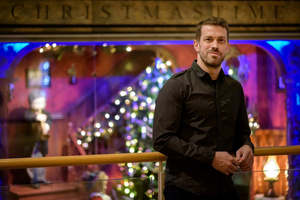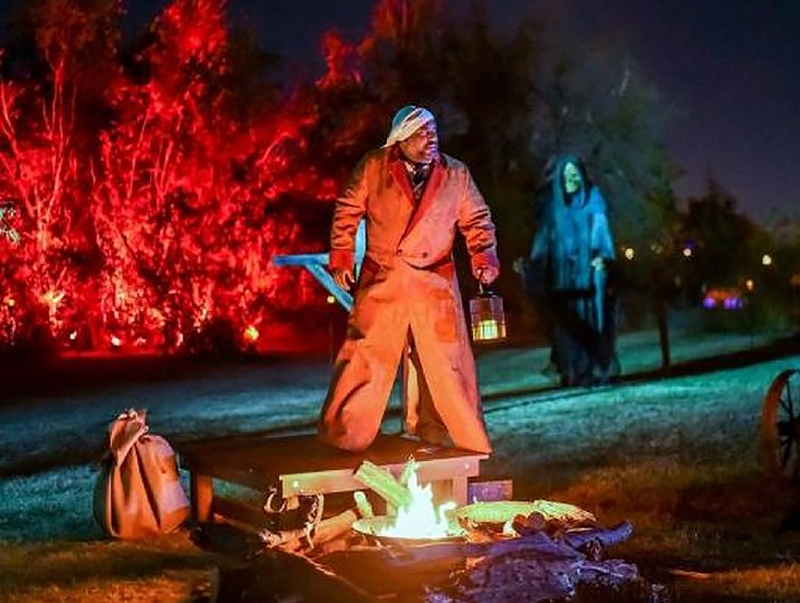Interview: Set Designer Adam Koch Shares the Joys and Challenges of Creating Outdoor Theatre During the Pandemic
Koch recently worked on the Lyric Theatre's immersive, outdoor production of A Christmas Carol.

Set and production designer Adam Koch has designed sets for over 50 productions worldwide, including A Wonderful World at the Colony Theatre, Beauty and the Beast at the Tuacahn Amphitheatre, Buddy: The Buddy Holly Story at
The Rev Theatre Co., Chicago at the Maltz Jupiter Theatre, Next to Normal at the Westport Country Playhouse, Our Brother's Son at Signature Theatre, and many more.
Recently, Koch designed the set for the Lyric Theatre of Oklahoma's immersive, site-specific, outdoor production of A Christmas Carol in November, where people walked from scene to scene across 10-acres of land at the historic Harn Homestead. Koch has a long history of working on non-traditional sets, and has been nominated for several awards including a 2015 Helen Hayes for Outstanding Set Design (1st Stage Theatre's 'Bat Boy'), a 2015 Syracuse SALT Award (Syracuse Stage, 'Hairspray'), and a 2009 Helen Hayes for Outstanding Set Design (Signature Theatre's 'Kiss of the Spiderwoman'). He is a recipient of both the USITT Oren Parker Award for Excellence in Scene Design, and the 2007 Kennedy Center Design Fellowship.
For more information on Koch's work, visit: http://www.adamkochassociates.com/about
We spoke with Koch about how he approaches a project, how the process of creating the set design for a production has changed due to the pandemic, and much more!
Talk to me about your process! What is the first thing you think about when beginning work on a new production?
As a designer, whether it's costumes or sets or lights, the first thing you want to think about is if you are able to give the director or producer their dream production. If they have a really clear vision about how the show should be, then why not give them exactly what they want? Now, a lot of times they will not have strong feelings, especially the more established you get as a designer, more and more someone is probably going to ask you, "Adam, I just want you to do your dream, give me your vision." For whatever reason, since I was a kid I loved musical theatre, the music of music theatre, the drama, the mystery, the excitement. And because music is what makes a musical not a play, that's probably the key to unlocking it's secret so to speak. As a theatre artist, I get excited by all parts of the theatre, the acting, directing, lights, music, costumes. Certainly music is the main inspirational element.
In olden days, the cathedrals, when they were designing and building those, there was an old saying that cathedrals are essentially music made visual. Visuals have a musical element to them, and different music looks like different things, you can visualize it. So, I'm always trying to unlock the specifics of a certain score or composition and make the invisible visible for the audience. That's why different musicals should look completely different. Using a standard set for different musicals is a total mistake because they should look completely different, they have different scores, different music, different inspiration.
You recently worked on the set design for an outdoor production of A Christmas Carol at Lyric Theatre. How did you approach that production in a creative way, knowing that the show also had to follow guidelines that would allow for a safe viewing experience?
Putting on shows this past year, fear is the biggest obstacle. The reason all of these things are shut down is because people are afraid of contracting a virus, and sometimes appropriately so, the risk is high in some places. But, when A Christmas Carol came along, I knew that an outdoor production would be possible. Michael Baron and Lyric Theatre of Oklahoma had the courage to say, "I know it seems scary to put on a show, but we can do it, we can do it safely." And gosh darn it, we did it, and I really appreciate that. Because, even I was thinking, "Is this smart? Is this safe?" But that was only fear talking. Once you do it and you do it safely, it's like, "Oh, you can do this, it is possible, there is light at the end of the tunnel for all this!"
Design-wise, luckily, one of the silver linings is that my last couple years of working in outdoor theatres with site-specific theatre work prepared me for this year, where it's the only way to do things! I'd previously done an outdoor Titanic, and Carousel, and Miss Saigon that were all challenging, as all outdoor work is, especially site-specific stuff. That perfectly set me up for this outdoor A Christmas Carol. The reason people get excited about these shows is that they're legitimately site-specific. So, for example, with A Christmas Carol, they found in Oklahoma City this Harn Homestead, which is kind of like a miniature colonial Williamsburg, an outdoor living museum. So, it's got all these old, historic buildings and houses and log cabins. And had it not been there, we probably would have designed A Christmas Carol Completely differently. But because this was the site that was chosen, those building inspired what it could be. So, you go, "Okay, we have this log cabin, that could be the Cratchit's house, we have this fancier old building, that could be Scrooge's office." It's like the opposite of working with a blank canvas, it's working with a canvas that's already kind of filled in, and you're working with it to fill in the rest of the details.
What was it like working with all of the other members of the team to bring that together outside, in a truly site-specific area?
 There's site-specific, like, one site, and then there's a lot of the stuff that I've done, which is multiple sites. So, this is really sites-specific work, A Christmas Carol happened at seven different locations. The audience would walk to this house, walk to that site, walk to this site, you're going on a journey with Scrooge. I've done lot of A Christmas Carols over the years, and the graveyard is always so disappointing because you're still in the city set that's always there, but this was legitimately in an outdoor field with this big, scary tree and all these gravestones, like an actual graveyard, it was so exciting.
There's site-specific, like, one site, and then there's a lot of the stuff that I've done, which is multiple sites. So, this is really sites-specific work, A Christmas Carol happened at seven different locations. The audience would walk to this house, walk to that site, walk to this site, you're going on a journey with Scrooge. I've done lot of A Christmas Carols over the years, and the graveyard is always so disappointing because you're still in the city set that's always there, but this was legitimately in an outdoor field with this big, scary tree and all these gravestones, like an actual graveyard, it was so exciting.
But, speaking of all those different locations, that's where the practicality of doing outdoor stuff really kicks in. Because essentially, each one of those sites is its own stage, you need sound, you need lighting. And so, the practical challenge of planning outdoor shows is how to spread your resources over all of those different locations. Because what if you only have enough lighting to cover five different locations? You're going to have to work backwards and condense your idea, etc. Sound too, you've got to have coverage over all those different areas. It's a kicked around word, but it's important: collaboration. Working with and collaborating with sound and lighting specifically, because as the set designer, I can say, "Oh, we can use this space and that space," I'll keep going, but we've got to work together to realize how much equipment there is to cover all of these different areas.
You've worked on an incredible number of shows. Have your thoughts on set design, and how you approach the design process, changed due to the pandemic?
On the one hand, the artistic process has not changed at all. Pandemic, no pandemic, the music, the script, the ideas, you still bite into those, and the design process reveals from there. In a way, the artistry hasn't changed, but the practicality and the function have of course changed for the time being [with] the safety protocols. It's a bunch of little changes. For instance, prop handoffs, making sure things are sanitized, and people can't hand each other things, and quick changes, and spacing things out. In a weird way, a lot of stuff that goes on behind the scenes has changed, but the audience might not ever know about it. We know we're doing it to keep the actors safe, behind the scenes. The nature of what we all do, and what we want to do, it's still the same, I think. We still want to move the spirit of the audience for a little bit. The goal is still the same, but there's just a lot more red tape in between.
Can you tell me about any projects that you have coming up?
Before March, me and my studio, my associates, my co-designer Steven Royal, we were working on like, ten projects at the time. Of course, they're all in different stages, rough design, final design etc. So, as things come back, there are all these shows that are slated to reopen, it's going to be a slow process as they all get back into gear. Some of them were already outdoor productions. For example, a big Beauty and the Beast that we're doing the sets and video and projection for out in Utah. There's Beauty and the Beast, Next to Normal, Sweet Charity, and a new musical called A Wonderful World that are kind of waiting in the wings, so to speak.
City by city, state by state, it's all a waiting game somewhat. In the meantime, so many companies have been looking to figure out a way to do something outside, and with all my outdoor design experience, we've been getting lots of calls and have branched out and started doing outdoor consulting work for city governments and for theatre companies. Money is tight, so they're all trying to figure out how to do these things on their own. So, they aren't looking for a full production design, but we've been doing consulting work to help people figure out the things they'll need, and the pitfalls to avoid when mounting an outdoor show for the first time. That's a new branch of the business that was not planned on, but was the result of the last year.
What are you most excited for when theatre can move forward in a less-restricted way, and things can go back to some sort of semi-normalcy?
As a professional, I'm excited to work again and make money doing the thing I love. But, more than that, I'll be more excited as an audience member, the first time I can sit down and watch a show without fear. When the curtain goes up, I will cry. I'm excited to not be afraid at some point, and watch a show with some kind of certainty that we're not putting each other in harm's way. I'm looking forward to seeing a performance with a group, and we're not thinking about safety.
For more information on Adam Koch's work, visit: http://www.adamkochassociates.com/
*This interview has been edited and condensed for clarity
Photo Credit: Tom Gilliam, K. Talley Photography

Videos

